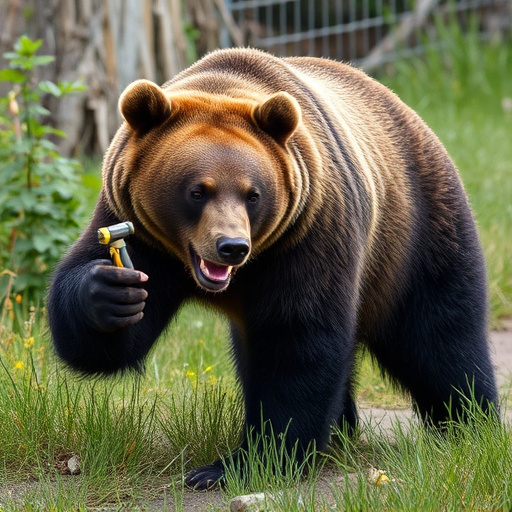In Alaska's national parks, understanding Bear Spray Laws is vital for safety while navigating wild landscapes. Bear spray, a legal requirement in many areas, can deter aggressive bears with correct usage (up to 92% success rate). The effective range is approximately 20-30 feet (6-9 meters), extending to 100 feet with calm winds, but varies based on terrain and wind conditions. Visitors must carry bear spray responsibly within the specified range and use it correctly to avoid legal issues and protect bears. Regular training enhances safety during encounters in remote settings.
“Alaska’s vast landscapes are home to diverse wildlife, including bears, making knowledge of bear repellent maximum ranges crucial for visitors. This article explores the effectiveness of bear spray in Alaska’s national parks and its role in ensuring visitor safety. We delve into the specific laws governing bear spray possession, focusing on regulations within national parks. Additionally, practical tips for maximizing safety while using bear spray in remote areas are provided to empower adventurers with the knowledge needed to navigate Alaska’s wilderness responsibly.”
- Understanding Bear Spray and its Effectiveness in Alaska's National Parks
- Bear Repellent Maximum Range: Unraveling the Distances
- Bear Spray Laws in Alaska: What Every Visitor Needs to Know
- Maximizing Safety: Tips for Using Bear Spray in Remote Areas
Understanding Bear Spray and its Effectiveness in Alaska's National Parks
In Alaska’s vast national parks, encountering bears is a reality for outdoor enthusiasts and residents alike. Understanding bear spray and its effectiveness is crucial for navigating these wild landscapes. Bear spray, also known as bear repellent, is a legal requirement in many areas of Alaska’s national parks. It’s designed to deter aggressive black and grizzly bears when used correctly. The spray creates an unpleasant experience for the bear, encouraging it to retreat rather than engage.
While bear spray isn’t a foolproof solution, it can significantly reduce the risk of bear encounters turning dangerous. In fact, studies show that when used appropriately, bear spray has a success rate of up to 92% in repelling bears. However, it’s important to note that the maximum effective range varies depending on factors like wind conditions and spray can quality. Always follow local guidelines, stay informed about bear spray laws in national parks, and know how to use it properly for maximum protection during your outdoor adventures.
Bear Repellent Maximum Range: Unraveling the Distances
In the wild landscape of Alaska, understanding the maximum range of bear repellent is crucial for visitors and residents alike. The effective distance of bear spray, a common repellant, varies based on several factors including wind conditions, terrain, and the size of the bear. According to Bear Spray Laws in National Parks, the recommended range for bear spray is typically around 20-30 feet (6-9 meters). However, in optimal conditions with calm winds, this distance can extend up to 100 feet or more.
Navigating Alaska’s vast wilderness requires knowledge of these distances. In dense forests where the air stays still, bear spray can be effective even at longer ranges. Conversely, open areas with strong winds might reduce the spray’s reach significantly. Knowing these variations helps visitors and outdoor enthusiasts make informed decisions for their safety while exploring National Parks in Alaska.
Bear Spray Laws in Alaska: What Every Visitor Needs to Know
In Alaska, bear spray is a vital tool for visitors navigating the state’s stunning but potentially hazardous wilderness areas, especially within national parks. The use of bear spray is regulated by specific Bear Spray Laws to ensure safety and minimize impact on both humans and wildlife. All visitors to Alaska’s national parks are required to carry bear spray as a precautionary measure against encounters with grizzly bears and black bears.
These laws mandate that bear spray be carried in an easily accessible location, such as a belt or backpack, and used only when necessary to defend oneself against an aggressive bear. The maximum effective range of bear spray is approximately 20-30 feet (6-9 meters), making it crucial for visitors to understand and adhere to these regulations. Using bear spray irresponsibly can lead to legal consequences and contribute to the stress or harm of bears, which are protected under state and federal laws.
Maximizing Safety: Tips for Using Bear Spray in Remote Areas
When venturing into remote areas of Alaska’s stunning national parks, maximizing safety while encountering bears is paramount. One effective tool for deterring bears is bear spray, but understanding its maximum range and proper usage is crucial. Bear spray laws vary across National Parks, with each park establishing guidelines for carrying and using these repellents.
For optimal effectiveness, users should familiarize themselves with the recommended distances specified on the product label. Typically, bear spray can be effective up to 20-30 feet (6-10 meters) when used correctly. It’s essential to follow instructions diligently, aiming towards the bear’s face and body while backing away slowly. Regular training and practice in using bear spray can significantly enhance your safety during encounters in these wild, remote settings.
In conclusion, understanding the bear repellent maximum range and adhering to Alaska’s bear spray laws are vital steps towards enhancing safety while exploring the state’s national parks. By familiarizing yourself with the effectiveness of bear spray and implementing practical tips for usage in remote areas, you can ensure a more secure experience amidst the unique wildlife of Alaska. Remember that knowledge and preparation are key when navigating these wild landscapes.
